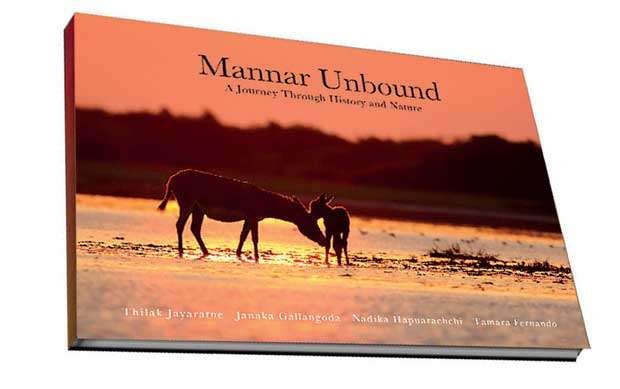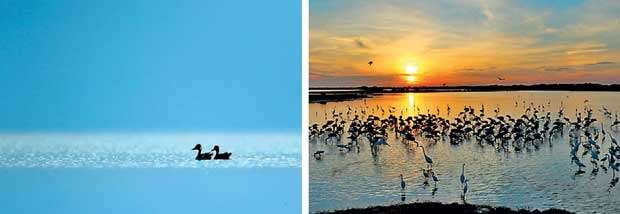Reply To:
Name - Reply Comment
Last Updated : 2024-04-27 00:40:00

 The setting sun sets fire to the dunes, bathing them in flames of gold and saffron. Silhouetted in the flaming light, a female donkey reaches out towards its foal. The foal, in turn, nuzzles its mother. A rare moment, full of love and magic; poetic, sensitive and deeply perceptive, it is our first impression of Mannar Unbound.
The setting sun sets fire to the dunes, bathing them in flames of gold and saffron. Silhouetted in the flaming light, a female donkey reaches out towards its foal. The foal, in turn, nuzzles its mother. A rare moment, full of love and magic; poetic, sensitive and deeply perceptive, it is our first impression of Mannar Unbound.
This a study of the history of the Mannar Peninsula and its surrounding environment. With intelligence, feeling and art, this work captures, explains and brings to life the living beauty of Mannar, its birds, its animals, its reptiles and its marine life. The last decade has seen two seminal works published on Sri Lanka’s environment -Rohan Pethiyagoda’s Horton Plains: Sri Lanka’s Cloud-Forest National Park (2012) and Asoka Yapa and Gamini Ratnavira’s mammoth study, The Mammals of Sri Lanka (2013). This could well be the third.
The preface hints at the touch of poetry which pervades this book.
“In the far left field.. are smatterings of islets arching gracefully out north-west, towards the Indian mainland. Resembling a sine curve, or tentacle, they follow from one large island, Mannar, in a trail of minor atolls, reaching out like a lover’s hand towards India.”
The writer clearly has a feel for words and an ability to use them. To this he adds a grasp of history, tracing the story of Mannar from ancient to colonial times. This history is fascinating and revealing. The strength of this work lies in the depth of its scholarship, in its substantial and original research. Intelligent, analytical and circumspect, it draws on a wide range of original sources, complemented by rare prints and drawings, some of them little known even to specialist scholars. Unearthing new truths, the narrative sets Mannar in its local and global context, explaining how it evolved, why it became important and why it began to decay.
As we begin to understand the real importance of Mannar as a trading hub, we also begin to realize why Sri Lanka looms so large in the maps of Greek and Roman cartographers. Frequently mentioned in the accounts of traders throughout the ancient world, its reputation was so great that the island appeared much larger than it really was.
Sifting through the history of Mannar two essential facts become every clear. In the Middle Ages, the tide of invasions from the north saw the removal of the royal capital from Anuradhapura to Polonnaruwa. This spelt the beginning of the end for Mannar, which was gradually superseded by ports on the eastern seaboard such as Trincomalee. The other factor behind its decline was the heavy silting of the deep channel which separated Mannar Island from the mainland. As the ease of navigation decreased over time, Mannar’s importance gradually declined.
In Dr. Tilak Jayaratne, Sri Lanka has a real historian in the making. This work makes a serious and substantial contribution to the history of Sri Lanka. It is so authoritative and so learned that the absence of citations is palpable. So is the absence of an index. Both of these are serious omissions in any work of scholarly importance.
The rest of the book is devoted to the environment. In words and images, it describes the dancing islands of Adams Bridge, the reefs of Arippu, Silawatura and Vidataltivu, the wetlands and salt marshes of Vankalai and the jungles of Madhu. Although this section is almost entirely visual, the cycle of the seasons is beautifully described and the various features of the environment clearly and simply explained.
The second part of this work concentrates on the migrating and seagoing birds which flock to the island between November and April every year. This has never been covered before in such depth. An important work of visual documentation and reference, it brings these rare birds to life, etching them firmly in our minds.
There is a great deal of original research here. Many of the species are little known and hardly seen. Both the Black Noddy and the Heuglins Gull are very rare and are only seen out at sea. We also see the extraordinary Knob-Billed Duck, which has started coming back to Sri Lanka after many decades.
Flying, feeding and landing, flamingoes, gulls, waders, terns and ducks come alive before our eyes. Some of the images are of rare quality. One of them depicts a Grey Plover on the mud flats. The tide has just come in, covering the mud. The Plover stands against an expanse of glinting blue, its brown markings picked out with the precision of brush strokes. As its beak glistens with mud, the lens is drawn towards its eye, a luminous glowing dot.
In many of the photographs, water, sky and sand are employed as visual tools. Clarity, contrast and detail are used with deliberate effect. So are the reflections, the ripples and the shadows. Through the eyes of Dr Janaka Gallangoda, the natural world becomes a form of art.
In many of the photographs, water, sky and sand are employed as visual tools. Clarity, contrast and detail are used with deliberate effect. So are the reflections, the ripples and the shadows. Through the eyes of Dr Janaka Gallangoda, the natural world becomes a form of art.
The highlight of this section is the “dancing islands” of Adam’s Bridge. For years they have been the least known and most inaccessible part of the island. Mannar Unbound reveals it to us for the first time. An expanse of open, empty spaces, swept by the wind and the tides, Adam’s Bridge changes shape from one day to another. It is the only place in Sri Lanka where there are sandstorms. With its gale force winds and sweeping sands at times, it is almost impossible to see. One of our most vivid glimpses is a blurred image almost buried in the sand. We can almost feel the sand on the camera lens, whipping in our faces.
For a few months every year these scorched and barren islands, come alive with thousands of birds, winter migrants. They congregate in their thousands because the shallow waters are teeming with fish, so much so that they seem to blanket the surface. Almost every bird depicted in this section has a fish in its beak.
We are told that in 2017 the birds abandoned the third island completely. This was “due to unrestrained human activities in the vicinity.” Visitors these days are more likely to see kite surfers, wheeling in the sky. Kite surfing it seems is the new cash cow for businesses of all shapes and sizes. As in Kalpitiya, tents and shacks have begun to litter the shores. Instead of the raucous sound of nesting, feeding birds, in the future visitors are more likely to hear thumping music and screams of glee.
The next segment of this work unveils the marine life of the area and is devoted to the reefs of Arippu, Silawatura and Vidataltivu. One of the most beautiful parts of the book, it reveals a world of breathtaking colour, so intense that it holds you and draws you in. Moray Eels lurk in crevices, massive turtles lumber towards the reader while Reef Sharks glide across his path. This is a different art form. Over the years, a great deal of underwater photography has been done in Sri Lanka; very little of it has been published. This is perhaps the first time that Sri Lanka’s underwater wonderland has been depicted in this way.

Nadika Hapuarachchi and Tilak Jayaratne was also to photograph the elusive and legendary Dugong. This is perhaps the single most important moment in the whole book. Large herds of dugongs once existed off Sri Lanka’s northwestern coasts. Over the last few decades, numbers have dwindled rapidly. In spite of numerous projects and years of fieldwork, there have hardly been any live sightings. This sighting represents a massive contribution to our knowledge of Sri Lanka’s marine environment. Hapuarachchi and Jayaratne have proved that the world’s rarest and most vulnerable mammal is still alive and well. It is a discovery of immense significance.
The design of Mannar Unbound is spectacular and original. Breaking with the usual format, Tharanga Aluthwala creates a complex and multi-layered work of art. He is able to play with colour and background and his sense of the visual is assured.
As an art of observation, photography requires an ability to see and a capacity to feel. Sometimes, it is transformed by the capacity to wait and the power to think. Concentrating his passion and his sensitivity on the natural world, Dr Janaka Gallangoda has evolved into an artist and photographer of calibre. To his eye for colour and detail, Gallangoda brings an intensity which only deepens his powers of sight. His intelligence takes his work to another level, enabling him at times to see beyond the visual.
Mannar Unbound is much much more than a book on the environment. It is also a potent advertisement for Sri Lanka As much as any other form of art, books are also tools; they can inform, engage and attract and inspire. In supporting this lavish production, Soft Logic have helped create a potent marketing tool associated with the beauty, history and diversity of Sri Lanka. In doing so, they acquired themselves a unique and beautiful brand label. This particular brand is not only of interest and importance, but it is also of enduring appeal.
A journey through the human and natural drama of the Mannar peninsula, Mannar Unbound makes us think and feel, it “colours and animates” our understanding and it makes us want to “explore and to protect.”

Add comment
Comments will be edited (grammar, spelling and slang) and authorized at the discretion of Daily Mirror online. The website also has the right not to publish selected comments.
Reply To:
Name - Reply Comment
US authorities are currently reviewing the manifest of every cargo aboard MV
On March 26, a couple arriving from Thailand was arrested with 88 live animal
According to villagers from Naula-Moragolla out of 105 families 80 can afford
Is the situation in Sri Lanka so grim that locals harbour hope that they coul